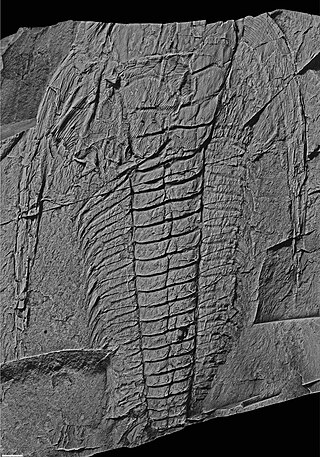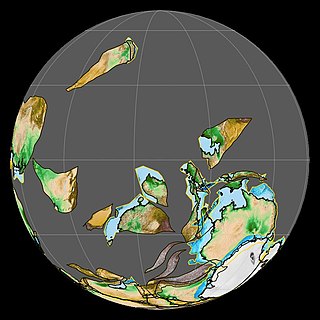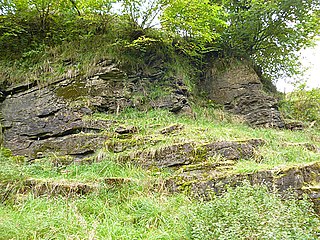
The Carboniferous is a geologic period and system of the Paleozoic that spans 60 million years from the end of the Devonian Period 358.9 Ma to the beginning of the Permian Period, 298.9 Ma. In North America, the Carboniferous is often treated as two separate geological periods, the earlier Mississippian and the later Pennsylvanian.

John William Salter was an English naturalist, geologist, and palaeontologist.
The Yoredale Series, in geology, is a now obsolete term for a local phase of the Carboniferous rocks of the north of England, ranging in age from the Asbian Substage to the Yeadonian Substage. The term Yoredale Group is nowadays applied to the same broad suite of rocks. The name was introduced by J. Phillips on account of the typical development of the phase in Yoredale, Yorkshire.

The Tournaisian is in the ICS geologic timescale the lowest stage or oldest age of the Mississippian, the oldest subsystem of the Carboniferous. The Tournaisian age lasted from 358.9 Ma to 346.7 Ma. It is preceded by the Famennian and is followed by the Viséan. In global stratigraphy, the Tournaisian contains two substages: the Hastarian and Ivorian. These two substages were originally designated as European regional stages.

The Visean, Viséan or Visian is an age in the ICS geologic timescale or a stage in the stratigraphic column. It is the second stage of the Mississippian, the lower subsystem of the Carboniferous. The Visean lasted from 346.7 to 330.9 Ma. It follows the Tournaisian age/stage and is followed by the Serpukhovian age/stage.
In geology, clay-with-flints is the name given by William Whitaker in 1861 to a peculiar deposit of stiff red, brown, or yellow clay containing unworn whole flints as well as angular shattered fragments, also with a variable admixture of rounded flint, quartz, quartzite, and other pebbles.

Edmund Johnston Garwood was a British geologist and President of the Geological Society of London from 1930 to 1932.

East Kirkton Quarry, or simply East Kirkton, is a former limestone quarry in West Lothian, Scotland, now a renowned fossil site. The quarry is known for terrestrial and freshwater fossils about 335 million years old, from the late Viséan stage of the Mississippian subperiod. The quarry is a 200-meter-long (~650 ft) depression located in the town of Bathgate. Geographically, it sits at the Bathgate Hills near the center of the Midland Valley, a fossil-rich region of southeast Scotland. The site is dominated by volcanic tuff, limestone, and silica deposits of large freshwater lakes associated with hot springs and local basaltic (high-iron) volcanism. Three geological intervals are exposed: the East Kirkton Limestone (oldest), Little Cliff Shale (middle), and Geikie Tuff (youngest).

Cyclida is an extinct order of crab-like fossil arthropods that lived from the Carboniferous to the Jurassic and possibly Cretaceous. Their classification is uncertain, but they are generally interpreted as crustaceans, likely belonging to the superclass Multicrustacea.

Cummingella is a genus of proetid trilobite in the family Phillipsiidae that lived from the earliest Carboniferous until the last species' extinction in the Middle Permian. Fossils have been found in corresponding marine strata of western Europe, the United Kingdom, and the United States.

The Eyam Limestone is a geologic formation in the Peak District, England. It preserves fossils dating back to the Viséan stage of the Carboniferous period, and represents a marine environment.

The Ballagan Formation is a geologic formation in Scotland and England. It preserves fossils dating back to the early part of the Carboniferous period. Its name comes from the "Ballagan Beds" of Ballagan Glen, near Strathblane, which has a good example of this geological formation.
This list of fossil arthropods described in 2018 is a list of new taxa of trilobites, fossil insects, crustaceans, arachnids, and other fossil arthropods of every kind that were described during the year 2018, as well as other significant discoveries, and events related to arthropod paleontology that are scheduled to occur in the year 2018.
The Holkerian is a sub-stage of the Viséan stage of the International Commission on Stratigraphy (ICS) geological timescale. It is one of five sub-stages commonly used in the Viséan stage within stratigraphy by British, Irish and other geologists outside the US and Asia.

This timeline of eurypterid research is a chronologically ordered list of important fossil discoveries, controversies of interpretation, and taxonomic revisions of eurypterids, a group of extinct aquatic arthropods closely related to modern arachnids and horseshoe crabs that lived during the Paleozoic Era.
Acanthorhachis is an enigmatic extinct genus of chondrichthyan from the Carboniferous period. Its name is derived from the Greek word acanthos meaning "spine" and the Greek suffix for spine, -rhachis. This is due to the spine-like dermal denticles and their subsidiary spines, which coated the exterior of the animal. The authors who erected this genus suggested the common name "The Spiny Spined Shark." The type species Listracanthus spinatus was in 1896 named by Herbert Bolton.

Ditomopyge is an extinct genus of trilobite belonging to the family Proetidae. It was extant during the Carboniferous and Permian and is widely distributed, with fossils found in Europe, southwest Asia, southeast Asia, Australia, North America, and South America.
Pugnoides is an extinct genus of brachiopod belonging to the order Rhynchonellida and family Petasmariidae. Specimens have been found in Devonian to Permian beds in North America, Asia, Europe, western Australia, New Zealand,and New Zealand. The genus was particularly widespread in the Visean.

Liobole is a lower Carboniferous proetid trilobite.
Richard Hill Tiddeman was a British geologist, known as a leading expert on the Carboniferous rocks of the counties of Yorkshire, Cumberland, and Lancashire.













